Heroes, Archetypes & Politics
“Perhaps, there’s a need to revisit another category of heroism: virtuous action and extraordinary bravery that arises out of something other than adherence to a personal code or ruined chivalric hierarchy, or to action in its own right as a dare to chance or fate. What about heroism dedicated to human commonalty; driven by loyalty both to actual people and to the institutions and cultures that nourish them?”—William Ramp
Small Things Recollected
By William Ramp
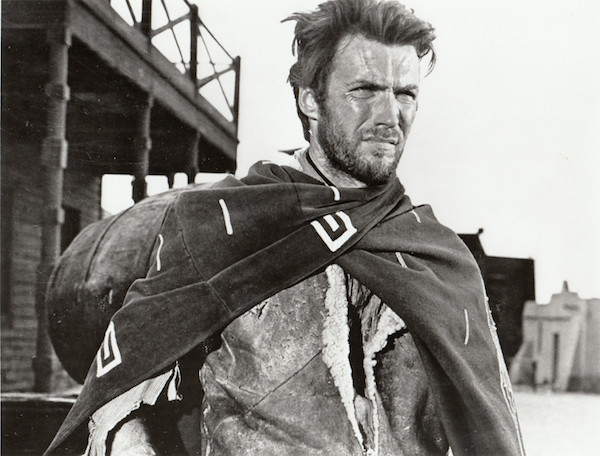
LETHBRIDGE, ALBERTA Canada—(Weekly Hubris)—March 2017— He stands at a crossroads in the midst of desolate mulberry fields; squints at the sky, picks up a stick and tosses it into the air. The direction it points when it falls into the dust at his feet gives him the path he takes. Silhouetted against an empty horizon, his robe flapping in the wind, he is a lone figure striding through a minimalist, empty landscape. I will follow him, in search of some archetypal and ordinary heroes and their political meanings.
The scene described above opens Akira Kurosawa’s 1961 classic, Yojimbo, a film that inspired a whole series of emulations, including the Westerns A Fistful of Dollars (1964) and Django (1966), the planetary fantasy The Warrior and the Sorceress (1984), and the crime thriller, Last Man Standing (1996).
Kurosawa’s lead character, Sanjuro, played by Toshiro Mifune, also paved the way for Clint Eastwood’s peripatetic persona; the lone, watchful, inscrutable “man with no name”—right down to the squint into the sun and the matchstick (or equivalent) clenched in the teeth.
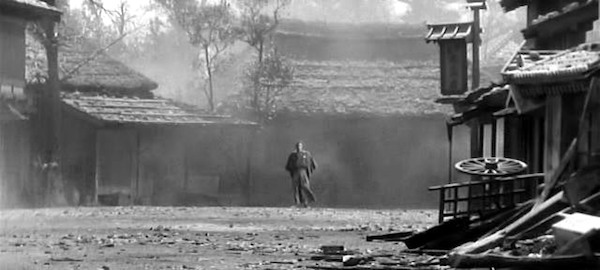
The setting of the film is Japan during the Bakumatsu period of the 1860’s, when a commercial middle class was gaining ground, setting the stage for the industrial and social upheavals that would lead Japan to world power status within 70 years. The increased commercial activity brought with it new shadow economies fed by gambling and prostitution. It was also the twilight of the social and military power of the samurai.
Sanjuro is a rōnin, a samurai without a master; trained in martial arts to fulfil a traditional role as defender of a lord; a person of noble inclination but rootless and divested of any status except that which he can make by his own wiles and skills.
He enters a town fallen on hard times, in which profits from the silk and alcohol trades have fueled gambling at the expense of traditional productive activities. Two criminal gangs vie with each other for power, and government officials have become their accomplices: ciphers of a mob. At first, Sanjuro poses as the sword-bearing equivalent of a gun for hire, bargaining with both gangs for his services as a bodyguard, and earning a rebuke from a local skeptic that he will share the fate of all the other thugs-for-hire. But Sanjuro maintains a precarious independence by playing the rivals against each other.
Eventually, however, his loyalty is taken, not by a gang, but by a prisoner, a farmer’s wife taken as a payment on a gambling debt, and forced into sexual services for a crony business owner. His commitment renders him vulnerable, and indeed he is eventually caught out, imprisoned, and beaten, as the turf war he has instigated escalates and one gang is eliminated. He escapes to recover in a graveyard and returns in the penultimate moment of the film to destroy the victors and free their prisoners. Then, he sheathes his sword and leaves, as he came, alone.
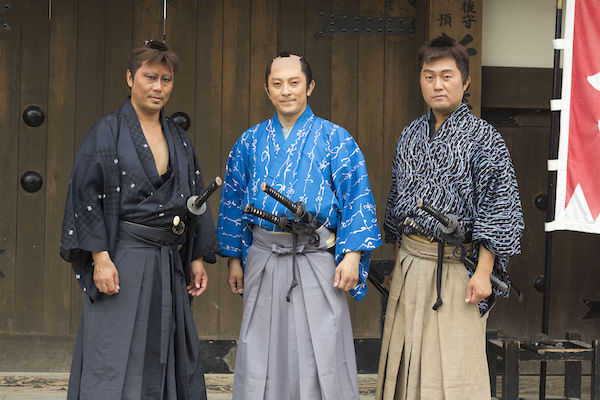
The rōnin is a figure similar in certain ways to the medieval European knight-errant, the “broken men” of suppressed Scottish clans, and the wandering guns-for-hire who operated on both sides of the law and reputability in the post-Civil War American West. It’s interesting that these figures all grew in cultural popularity in the 19th and 20th centuries (even as their real influence faded to memory), in very different societies. One might expect lone heroes to be stock figures of American individualism, but that they arrived in Hollywood via a Japanese and Italian detour seems to present a puzzle.
What makes them attractive to members of individualistic and hierarchical societies alike?
The best answer, I think, lies in the historical processes of modernization described so strikingly in the first chapter of Marx’s Communist Manifesto, in Max Weber’s monumental studies of economic and institutional rationalization, and in Karl Polanyi’s The Great Transformation. The global “liberation” of resources, raw materials, human labor and financial instruments from traditional and local strictures released enormous amounts of social and economic energy, but came at an equally enormous cost to forms of human emplacement, interaction and production outside of the abstract “cash nexus” and the expropriation and exploitation that made it possible.
In my last column, I discussed Walter Benjamin’s claim that the modern novel, as a distinctive cultural form, came of age in an era which privileged individual self-definition within and navigation of an uncertain world for which traditional wisdom and morality no longer provided sure guidance. Despite this new stress on individualized biographical identity, recognition of one’s efforts to live a meaningful and justifiable life became more fickle and fleeting. It was possible not only for outlaws but for anyone to become human detritus.
To meet this changed regime of recognition, new forms of literary heroism developed: the hero as inhabitant of the fractures of modernization, both embodying and resisting the values of the new order. One thinks of Clark Gable’s Rhett Butler in Gone With the Wind: the parvenu who ends up not giving a damn, yet who joins the Battle of Atlanta on behalf of the doomed Old South—not because he believes, but simply to do something for a side; to be loyal to some loyalty regardless of content. The opposite of money, loyalty here mirrors it: a signifier without anchor.
Sanjuro, like the classic hero of so many Westerns, follows a different path. He arrives, he engages in battle, but from a position of detachment. And in the end, after streets are littered with the bodies of fools who had thought themselves victorious, he leaves. No-one knows where he will turn up next.
But he is vulnerable; he carries along with his sword an affinity for traditional virtues and allegiances that no longer apply, and for a humanity that is non-negotiable (and thereby worthless in trade or speculation). He is outside of society and exposes its falsity, but his actions are meaningless without it, and the possibility of its return to justice and peace attracts him, even as peace expels him, for he has no more role once it is re-established.
Hero figures or close equivalents appear in many cultures at different times, but differently, making any universal definition difficult. That’s not to say it hasn’t been tried.
In his 1936 study, The Hero, A Study in Tradition, Myth and Drama, the amateur folklorist, Lord Raglan, proposed a mythic-hero archetype composed of 22 common characteristics. Joseph Campbell, a perennially-popular intellectual renegade, himself a hero-figure for many of his readers, proposed the existence of a universal “hero’s quest” narrative archetype in his 1949 magnum opus, The Hero with a Thousand Faces.
In the past half-century, heroic universalism of this sort has received a severe battering: contemporary academic historians who ascribe causality to individual heroism, or anthropologists who take Campbell seriously, are now rare. There may have been those who hoped that the structuralism of a Levi-Strauss or a Propp might give rise to a universal semiotics or semantics of heroism. But such was not to be.
Hero figures have become cultural artifacts to be explained or deconstructed in terms of specific contexts or particular social, linguistic, or discursive practices. For those who hunger after the certainty of the universal, this loss of faith in “the” heroic archetype indicates the blindness of a modern academe poisoned by the likes of Derrida, Foucault, and devotees of both the longue durée and microhistory.
Full disclosure here: I am an academic skeptic and I admire Derrida more than Campbell, who strikes me as a painter with far too broad a brush, fascinated by symbolic diversity but driven by a wishful urge to reduce it all to some ur-configuration.
Still, I too sense in the variety of the heroic certain commonalities. I think these derive from a collective need to subject shared meanings and ideals to a process of ritual condensation; to personalize and embody them in figures who are exemplary and symbolic in being and action.
Typically, though, heroic figures also stand apart from their communities; they are to some degree individualized. They may lead, protect, and represent a company of peers or a people, but they are not reducible without remainder to either. They often have personal flaws, vulnerabilities, or weaknesses by which they are particularized, which they must overcome, or by which they are doomed. Most often, they are not at home in settled times; they arise in moments of strife or the crumbling of old moral or institutional verities. They engage in conflict or go on journeys or, more typically, both.
Heroes are not often kings.
But beyond these very vague and broad commonalities, the search for heroism must quickly become localized.
The word “hero” is said to descend etymologically from the Indo-European root *ser, meaning “to protect,” and both the strengths and weaknesses of heroes in the Western literary traditions are often related to an impulse to protect. It is worth noting in this regard that the term “hero” is heavily coded as masculine, with the derivative “heroine” being reserved for women who fit the template. As the sociologist Emile Durkheim noted (without fully understanding the import of his observation), both individualism and the representative human figure, as these developed in European culture, had deep roots in patriarchy.
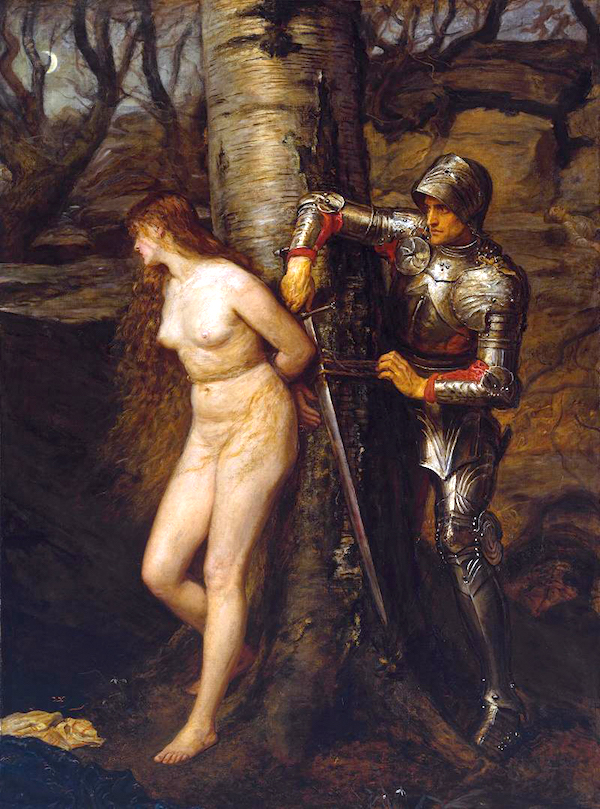
Back to Yojimbo: what roots can we trace for this kind of lone, almost accidental hero? I would suggest two possibilities; the tragic hero and the knight-errant.
The philosopher Aristotle defined the tragic hero in Greek drama as a person of noble birth or origins and extraordinary capabilities, who embarks on some great or admirable course of action out of virtuous motives, but who is brought low through a vulnerability exposed in some error in judgement, or by an unexpected injury, as in the figure of Achilles. There may be a moment of truth in which the hero realizes this mistake and recognizes the true course of things by which he is doomed.
There is a wider sense implicit here: the course of events which dooms the hero is often represented as implacable. The hero is brought low by fate, moira, or perhaps more accurately, ananke. He stands out briefly against the wheel of time which will crush him. In classical tragedy, there is no modern notion of progress over linear time.
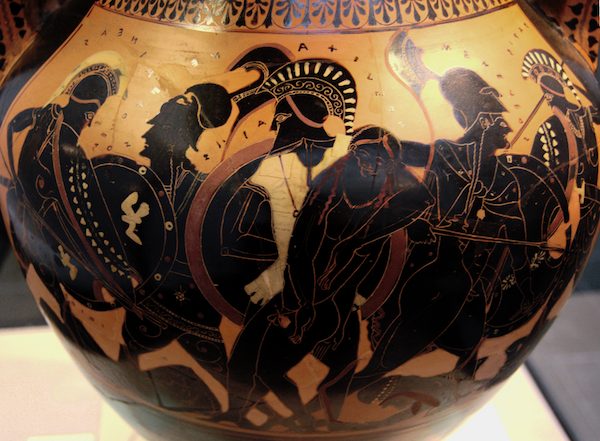
Sanjuro, the broken samurai, exhibits both virtue and extraordinary capability, despite having been brought low before the beginning of the film’s narrative. He is also vulnerable to a tale of a woman of virtue imprisoned and used by criminals. His actions on her particular behalf almost cause his death. Yet he returns and is victorious.
But Sanjuro is more a survivor than a victor. The film ends with an indication but not a guarantee of personal or civic progress, of future productivity, or of a return to order, civic virtue, or traditional verities. Sanjuro himself departs as he came; on foot, with no firm destination, and essentially unknown. Nothing much has changed except for the deaths of a cast of characters. The wind still blows. Compromised figures still inhabit the town. Will fate return it to a fall? The question remains open.
This peripatetic existence links Sanjuro cross-culturally to the figure of the knight-errant, released temporarily or permanently from service to a local overlord and embarked on a virtuous quest. Again, though, there are key differences. Sanjuro travels alone, not in company. His virtue resides not in the object of a quest, but in his person. He has neither destination, nor destiny. He navigates as much by chance as do the crime-syndicate gamblers he confronts and destroys. His world is structured by the inexorability of the political changes and world markets to which Japan has been opened by Perry’s black ships, but the fate that gives him is as inscrutable as a machine and as arbitrary as a broken engine; it is a reality rather than a truth.
But how has this loner hero become so culturally attractive?
First, that hero’s context mirrors our contemporary one. A thousand advice books, tens of thousands of career counselors and life coaches, and millions of memes seek to convince us that the worlds of personal relationship, self-potential, employment, and wealth are mappable and conquerable if we adopt the right attitudes, choose our particular passions, and believe in ourselves. But modernity presented itself only briefly as freedom before industrial and institutional routine settled over civilization like volcanic ash.
Today, the uncertainty of deregulation promises entrepreneurialism but delivers anxiety: risk is the new routine. At the same time, our place in this inexorable stasis is never guaranteed. More and more of us must choose agonizingly and repeatedly between family, location, community, and employment, all of which are available by chance of birth and circumstance, or until the advent of the next economic crash, the next illness, the next outsourcing, the next wave of robotization, the next political or military convulsion, the next great extinction. Like Sanjuro, we must navigate the cracks between intractability and uncertainty, without guarantee.
Second, these conditions constantly threaten to drown us, to rob us of dignity, to turn us into losers. The hero’s ability to retain dignity, even in loss, attracts. The hero’s ability to retain virtue gives hope that fatal complicity is not the only available possibility.
Third, Sanjuro’s message gives both pessimism and hope attractive forms. Sanjuro’s detachment mirrors the cynicism with which we approach the various systems that govern our lives. Yet that detachment allows hope of salvaging some shred of individual dignity and independence from fate. At the same time, Sanjuro’s destruction of gangsters and liberation of prisoners offers hope to idealists that virtue could triumph; that individual virtuous actions might count in some larger sense. In a recent article in The Straddler, Dan Monaco suggests that Sanjuro actually models a form of administration which, unlike that portrayed by Kafka and experienced by so many, is neither mindless nor amoral. Monaco writes:
“What is most remarkable about Kurosawa’s samurai, however, is not the skill with which he handles all of the uncertainty and contingency in a system which he is given—but rather that he actually participates in the machinations of a system that he is simultaneously, and surreptitiously, administering against.
“The samurai is thus an organizational revolutionary operating on two levels of contingency. He gains entry to the town, and access to its governing precepts, not as an administrator, but as a putative mercenary seeking mere personal gain from the system’s functioning. But precisely by adopting this pose, he gains an opportunity to set up and administer a shadow system (rooted in something approximating an objective moral standard—or at the very least, something transcending and precluding mere material personal gain) which cannibalizes the old one.
“What is administered by the samurai is the elimination of overweening greed, scheming and retributive violence, the shirking of official responsibilities, and a cycle of warfare that attracts worse and worse elements to the town—elements that are exacerbated both by their sheer presence and by their seemingly endless supply.”
However, there is a basic problem with heroes, as with other symbolic figures. They can both inspire virtue and sap it. The act of projecting virtuous wishes and dreams on to symbolic figures can energize those who find fellowship in following a model. On the other hand, projection can encourage passivity and a kind of blindness in which heroism safely inhabits another time and place, or a kind of placeless eternity. This can detract from a responsibility to the present. Yojimbo and its derivatives can thereby appeal both to those who see virtue as an enactable possibility, and to those who see it as doomed.
The detachment of the lone hero can also encourage an over-personalization of virtue and its separation from common life; a cynical belief that the social arrangements of ordinary humanity are ultimately not really worth saving or ameliorating; that ordinary humanity itself is somewhat contemptible. And it can lead to a gnostic neglect of history. Neither the Bakumatsu period nor the Wild West was timeless. They resulted from quite specific decisions, circumstances, and consequences. Elitist cynicism is alive and well in many spaces of North American culture, online and in the flesh; in barrooms and in legislatures; on streets and in executive suites. It leads in the direction of Dirty Harry, the Clint Eastwood character who enforces the law by disregarding its niceties. We have seen and are still seeing the results of that mindset.
It could easily be argued that today, North Americans face a new age of institutional, infrastructural, economic, and political breakdown in which politics and economics come to resemble gangsterism and gambling; in which structural and institutional violence take on more naked and lethal forms; in which increasing numbers of the once-privileged come face to face with circumstances long faced by the structurally-disadvantaged and ignored. Thus, it could easily be said that there is a corresponding and growing need for new heroes with whom to identify.
It is one thing to moralize about this and to say “We don’t need new heroes,” but moralism rarely is effective. To say that we are all engaged in ordinary heroism has some truth to it perhaps, but so does the claim that we are also all engaged in some degree of complicity with the systems driving the degradation of humans, animals, soil, air, and water. What sorts of heroism might merit suspicion or cautious encouragement?
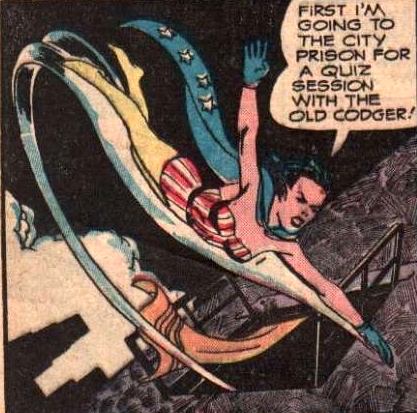
I would suggest, for reasons I don’t have space to elaborate on but that David Graeber has expressed eloquently here, that the Hollywood superhero genre, nurtured by the heroic age of American technological optimism, is no longer a particularly good place to look for a kind of heroism that encourages democratic, collective responsibility. The lone and virtuous heroes of Yojimbo or American Westerns provide certain other possibilities, though they partake of similar weaknesses. Beyond models of personal courage and independence, their genres do give a clear warning that heroes are vulnerable (as are we all); that they can only do so much (as can we all), and that they risk making catastrophic mistakes (as do we all).
Perhaps, there’s a need to revisit another category of heroism: virtuous action and extraordinary bravery that arises out of something other than adherence to a personal code or ruined chivalric hierarchy, or to action in its own right as a dare to chance or fate. What about heroism dedicated to human commonalty; driven by loyalty both to actual people and to the institutions and cultures that nourish them? Nelson Mandela, Helen Suzman, or Martin Luther King come to mind, as do figures such as Malcolm X, or Patrice Lumumba, all of whom suffered exile, ostracism, or betrayal; all of whom accomplished extraordinary things at great and sometimes fatal personal risk; all of whom were flawed. What about the possibility that their heroism resides less in what they accomplished than in what they began, and what they were able to hand off to others to fulfil?
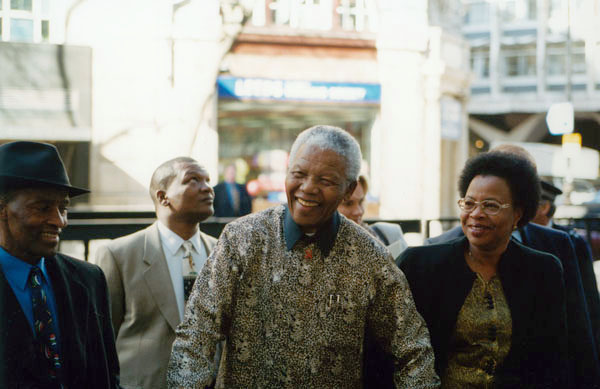
I teach for a living, and so I am somewhat susceptible to the kind of hero genre represented by the 1989 film, Dead Poets Society, in which Robin Williams delivers an unforgettable performance as John Keating, an inspirational and unorthodox poetry teacher.
Keating, dedicated to his students rather than to their parents or the school’s administrators and donors, is eventually dismissed, bearing on his shoulders the burden of a student who, caught between inspiration and familial and institutional fate, commits suicide. But, the film suggests, he begins something in the minds of his students.
However, I am drawn instead now to a more unassuming hero who also tried to begin something.
She was a student but, with a small band of companions, she took on the burden of teaching in objectively hopeless circumstances. Her name was Sophia Magdalena (“Sophie”) Scholl (and I can’t help but note that Sophia is also the name of the goddess of wisdom). She was a 21-year-old biology student at the University of Munich in the summer of 1942, when she became involved, along with her brother, in the White Rose, a clandestine group that wrote and distributed pamphlets calling for passive resistance to the Nazi regime. She and her brother were arrested on 18 February 1943, tried before the notorious Nazi judge Roland Freisler on the 22nd, immediately sentenced to death, and executed the same day.
Sophie Scholl is reported to have said at her trial, “Somebody, after all, had to make a start. What we wrote and said is also believed by many others. They just don’t dare express themselves as we did.” It is noteworthy here that her resistance work did not involve elite manipulation of the Nazi administration, but ordinary passive resistance. She stepped forward as an individual (“somebody had to make a start”) but not as a detached figure. She did so on behalf of others who believed as she did; others she hoped would soon also act with her.
At her execution, Sophie reinforced this stance:
“How can we expect righteousness to prevail when there is hardly anyone willing to give himself up individually to a righteous cause? Such a fine, sunny day, and I have to go, but what does my death matter, if through us, thousands of people are awakened and stirred to action?”

My interest in the heroism of Sophie Scholl is also sparked by other considerations. I am one of many who have drawn attention to tactical parallels between the politics of the current incumbent of the White House (and his advisors, backers and allies) and those of the Nazi regime, its paramilitary organizations, and its precursors and allies. As in the Germany of 1931-1933, radical Republican activists and legislators in state and federal arenas are busily stripping away human and civic rights that liberals and centrists once took for granted, in a punishing series of shock-and-awe executive orders and legislative proposals. As then, at least a few US police and border officials are embracing new and harsher mandates. As then, hate groups are becoming daily more emboldened.
However, there are dangers in drawing such parallels. The point is not to deify Sophie, but to emulate her example thoughtfully. The point is not that she provides a universal message from a now-distant time, but that that there are specific parallels between her circumstances and ours that bear watching.
There are also specific differences. We are not witnessing a simple return to 1940s fascism, despite the manifold parallels. What is now gestating is something both old and new, and any comparison of times, circumstances, and strategies needs to be critical, discerning, and situated. Sophie’s sister wrote about her that “perhaps genuine heroism lies in deciding to stubbornly defend the everyday things, the mundane and the immediate.”
Take for example Sophie’s brave assertion that what she and her companions wrote and said was also believed by many others who just didn’t dare express themselves as the White Rose activists did. Do you remember similar statements being made at campaign rallies before last November’s presidential election? They were made about Donald Trump; a man who, in the eyes of a rather large sector of the US population, remains a hero; a defender and protector of a once and future Great America.
However, those who are disturbed by and wish to resist recent political developments in the United States (and their parallels elsewhere), who inhabit universities that allow their critical autonomy to be undermined, who retreat before the creeping barrage of bad news about the erosion of human rights and of compassion, about the exploitation and destruction of human capacities, and about rapidly-accelerating climatological disaster need to hear Sophie’s other words: “Somebody, after all, had to make a start.” How otherwise can we expect righteousness to prevail, or even to have a chance?

Sources
“. . . the historical processes of modernization described so strikingly . . .”
- Karl Marx, The Communist Manifesto (Oxford: OUP, 2008)
- Max Weber, General Economic History, Part 4 (New York: Dover Publications, 2003)
- Karl Polanyi, The Great Transformation: The Political and Economic Origins of Our Time (Boston: Beacon Press, 2001)
“In my last column, I discussed Walter Benjamin’s claim . . .”
- William Ramp, “Heads and Tales: Story in an age of (dis)information.” Weekly Hubris, February 3, 2017.
“. . . his 1949 magnum opus, The Hero with a Thousand Faces . . .”
- Joseph Campbell, The Hero With a Thousand Faces, third ed.(Novato, CA: New World Library, 2008)
“As the sociologist Emile Durkheim noted . . .”
- see William Ramp, “Paradoxes of sovereignty: Toward a Durkheimian analysis of monarchy,” Journal of Classical Sociology 14(2), 2014.
“The philosopher Aristotle defined the tragic hero in Greek drama as . . .”
- Aristotle, Poetics. tr. A. Kenney. (Oxford: OUP, 2013)
“In a recent article in The Straddler . . .”
- Dan Monaco, “Yojimbo and Administration,” The Straddler, Fall 2010:
- David Graeber, “Super Position,” The New Inquiry, October 8, 2012.
“The lone and virtuous heroes of Yojimbo or American Westerns . . .”
- See “The Western Heroes,” n.d.
“Her name was Sophia Magdalena (“Sophie”) Scholl . . .”
- See Matt Lebovic, “Trump win sprouts ‘white roses’ in spirit of anti-Nazi youth,” The Times of Israel, Nov. 23, 2016.
- See also Margie Burns, “Sophie Scholl and the White Rose,” The International Raoul Wallenberg Foundation, n.d.
“I am one of many who have drawn attention to tactical parallels between . . .”
- William Ramp, “An Admonition,” Weekly Hubris, March 23, 2016.
“Sophie’s sister wrote about her that . . .”
- Margie Burns, “Sophie Scholl and the White Rose,” The International Raoul Wallenberg Foundation, n.d.

About the Illustrations
Image 1
“Publicity photo of Clint Eastwood for A Fistful of Dollars, 1964,” Wikimedia Commons, public domain.
Image 2
“Toshiro Mifune as Sanjuro in Yojimbo: lone hero in a wide frame,” Wikimedia Commons: public domain.
Image 3
“Actors portraying ronin on left and right, employed samurai in center,” Wikipedia, photo by Japanexperterna.se, 2014. Licensed under Creative Commons Attribution-Share Alike 3.0 Unported license.
Image 4
“Fantasies of heroic masculinity: John Everett Millais, ‘The Knight Errant,’” Wikimedia Commons: Public domain.
Image 5
“Ajax carrying the body of Achilles from the battlefield,” Wikimedia Commons, available for reproduction under the Creative Commons CC0 1.0 Universal Public Domain Dedication.
Image 6
“A different superhero: Interior artwork, likely from Captain Flight Comics (1947) by an unknown artist,” Wikimedia Commons: Public domain.
Image 7
“Nelson Mandela at the London School of Economics, 2000,” Wikipedia. From Library of the London School of Economics and Political Science, via Flickr’s The Commons.
Image 8
“Members of the White Rose resistance group, including Hans Scholl (left) and Sophie Scholl, Munich, 1942,” Public domain header photo for article, “Trump win sprouts ‘white roses’ in spirit of anti-Nazi youth,” The Times of Israel, Nov. 23, 2016.
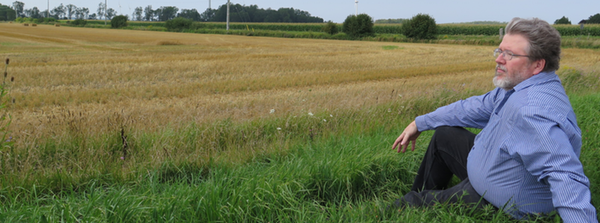
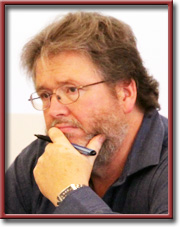
4 Comments
Will B
a brave and considered argument for heroism in our parlous time . . . thanks, Bill.
William Ramp
Thanks Will. We will need such heroism as Sophie’s in the days ahead. Somebody has to “make a start.”
jerry
Thanks, Bill, for such a deep and considered article, particularly since it rotates around my favorite movie and my favorite cinematic hero, Sanjuro!
There is a timeless quality about Toshiro Mifune, the actor who plays the role of Sanjuro, as there is about Clint Eastwood, our American Samurai, a quality that I have always found mesmerizing and which continuously speaks to a deep longing within me, a longing that includes entwined questions of masculinity, courage and rectitude.
To me, “Yojimbo” is the question of life laid perfectly bare within an exciting thriller, set in a sparse, dusty landscape that spotlights the morals and actions of the humans inhabiting it. Here we can clearly root for the courage of a man, and, by extension, of any or all men, including ourselves.
Yet, as you point out, it’s not all that simple. Motivations are uncertain, results are fleeting, the world moves on.
Sanjuro is Yin and Yang personified, as are we all – the good and the bad, the directed and the distracted, the winner and the defeated (perhaps eventually, as you point out). This is the power and beauty of Mifune as Sanjuro and Eastwood as the High Plains Drifter. Each hero of these movies moves through life with a personal power that is breath-taking in its rarity and confusing in its lasting results.
So what can this mean for us? You are right to bring Sophie Scholl to our attention (I had never heard of her before, but WOW!), as she personifies real-world heroism in her actions and, just as importantly, in her challenge to everyone everywhere:
” What should I do?”
As you can see, you really got me going – your richly rewarding writing has deepened and rounded out my slash-and-burn joy for this movie!
William Ramp
Jerry, you have written more than a comment: it serves as a coda to the article. Beautifully-written, too — “…a personal power that is breath-taking in its rarity and confusing in its lasting results” perfectly captures my own love of and unease about the genre.
And yes, Sophie Scholl did lay down a challenge to us all, along with her life –a challenge to be met every day, no matter how ordinary, in the extraordinary circumstances in which we now find ourselves.